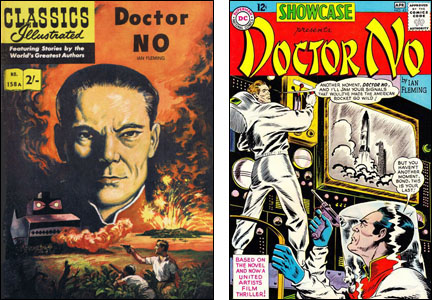
I got to discussing this with some folks at the Mid-Ohio Con and they all suggested I post this story here. It's the story of how, during the James Bond craze of the sixties, DC Comics had an option to publish a 007 comic book and didn't know it.
The first Bond film, Doctor No, debuted in England in October of 1962. To coincide with that release, the British publisher of the Classics Illustrated comic book series issued an adaptation that was drawn by Norman J. Nodel. It was not, by the way, a terribly precise adaptation, at least of the movie, which Nodel does not appear to have seen when he drew the book. It has been suggested that the publisher had the right to adapt the screenplay but not necessarily the film based on it. The likeness of the lead character makes it seem like Nodel was told to draw a Bond that looked a lot like Sean Connery…but not exactly.
In any case, the company that arranged the adaptation wanted to have it published in America when the movie was released here the following May. The American publisher of Classics Illustrated was in no position to do so. They had a marketing program that avoided most of the main newsstand outlets — the obvious place to sell such a book — and concentrated on classrooms and other educational venues. The Bond people, not wanting to miss an opportunity, tried to arrange to publish the Doctor No comic book themselves. They approached the largest comic book distributor, Independent News, which was owned by the same folks who owned DC Comics.
Independent said no, they would not handle a one-time publication from a new publisher…but they would buy the rights to publish an American edition and issue it as a DC Comic. The Bond licensing people liked this deal or at least accepted this deal. They did like the idea, which was briefly discussed, of DC publishing an ongoing James Bond comic book if this first one did well. The contract when it was concluded included an option clause that would allow DC to do a regular series for a modest fee.
Rumor has it that this clause was tossed in by the Bond people and that DC was generally indifferent to the notion. George Kashdan, who was the editor at DC involved in the Doctor No one-shot, told me that DC Management felt it was in the business of promoting Superman and Batman, not properties owned by others. The company rarely bought the rights to publish someone else's characters. They tried it a few times — often for reasons other than they thought it would yield a best-selling comic — but usually avoided such arrangements. Kashdan did not know why they made an exception for the Doctor No adaptation but theorized that it was cheap (the material was already drawn and the Bond people didn't want a lot for the rights) and maybe that someone was doing a favor for someone else.
DC published the Doctor No adaptation as a badly-timed issue of an anthology comic in which they tried out new ideas, Showcase. It was #43, which came out in January of '63 and was long off-sale by the time the movie was released in the United States. I remember it as a very odd presence on the newsstand. The cover was drawn by longtime DC artist Bob Brown but inside, it looked nothing like a DC Comic. It had dark, sterile artwork with typeset word balloons. Nothing like that had ever appeared in a DC title before and nothing like it has been in one since. (The cover, by the way, did not exactly proclaim it as a movie adaptation. It said, "Based on the novel and now a United Artists Film Thriller!" That suggests the company that did the original adaptation did not have the right to depict the movie, though there are scenes in the comic book that would suggest they did.)
Showcase #43 did not sell well. If it had come out after the movie opened in the U.S. and had sported a photo cover of Sean Connery and Ursula Andress, I suspect it would have outsold Superman. But that didn't happen and almost immediately, everyone in the DC office just forgot about it. Few of them knew about the option and none of those who did, as the film series got hot, thought to say, "Hey, why don't we do that James Bond comic?"
It was not discussed up there until early '72 when one of DC's business folks noticed that the ten-year option was about to expire and mentioned it to then-publisher Carmine Infantino, who was quite surprised. There was some brief discussion of exercising the option and starting the comic immediately — they spoke with Jack Kirby about drawing it, as well as with Alex Toth and some others — but DC ultimately decided against it. Sean Connery had just made what he swore would be his last appearance as 007 — Diamonds Are Forever — and there was some question as to whether the world's most famous spy had much of a future…or what James Bond could even look like.
Eventually, there were occasional Bond comic books, though not from DC. They never caught on, and one wonders if a DC book in the sixties would have sold for very long with as little sex and violence as it would have contained. But it sure would have been hot for a few years there when everything that said "007" on it was a top-seller. There's a long, much-discussed list of reasons why Marvel passed DC during that period as the top publisher of comics in America. You can add to that list that no one in the DC business department thought to mention to the editorial division that they had this cheap option on the hottest property in popular fiction…